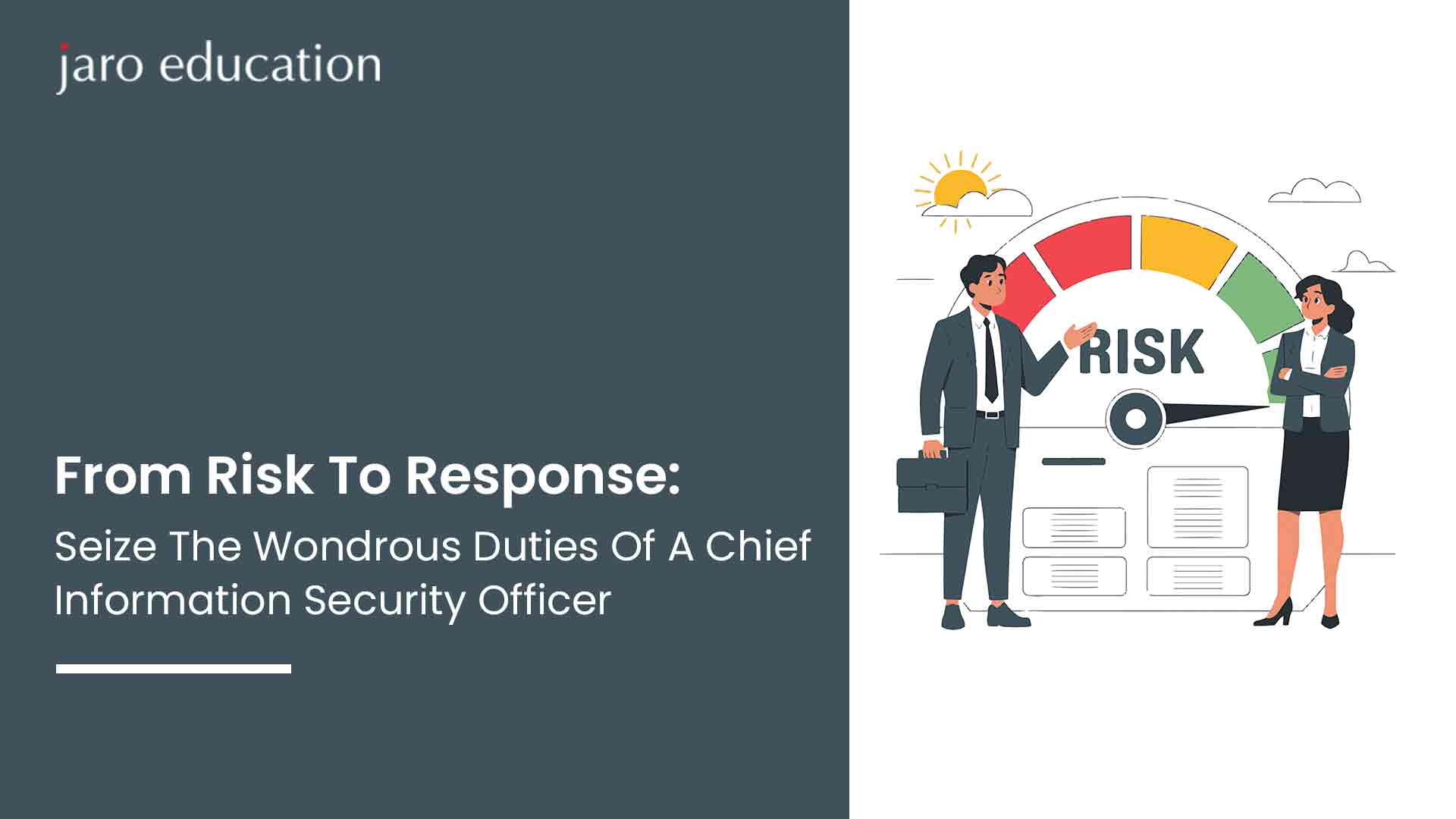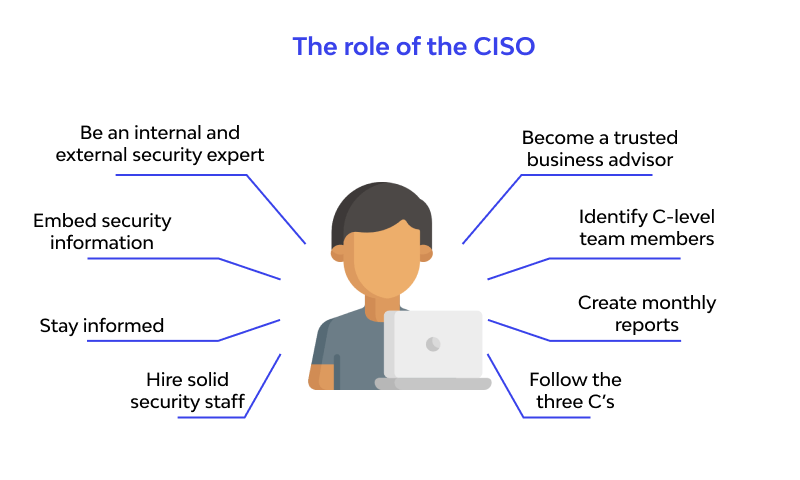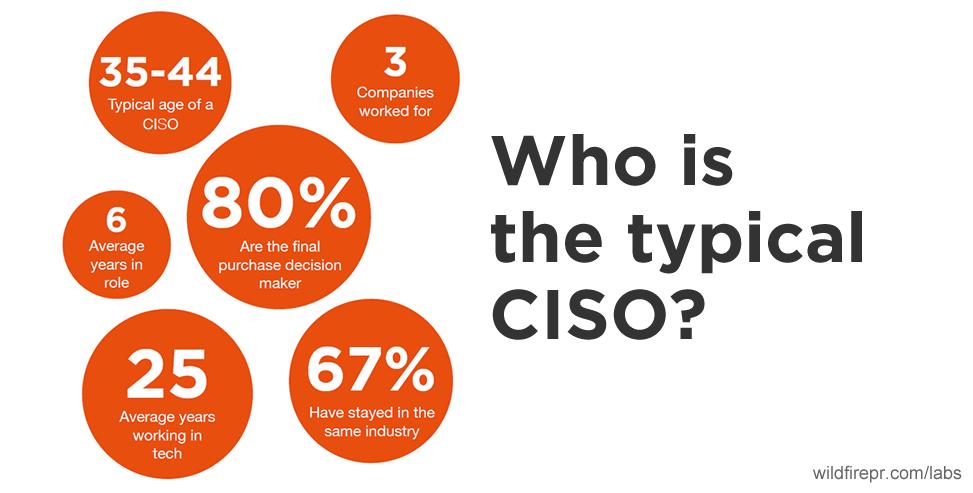From Risk to Response: Understand the Wondrous Duties of a Chief Information Security Officer
Table of Contents

- jaro education
- 14, October 2024
- 4:00 pm
Imagine this: you’re at the helm of a massive ship, navigating through a sea of unpredictable storms, rogue waves, and hidden reefs. This is what it’s like to be a Chief Information Security Officer (CISO) in today’s world—a strategic captain guiding an organization through the vast, sometimes treacherous waters of the digital age. Cyber threats lurk beneath the surface, and while some may view them as danger zones, a CISO sees them as challenges to overcome, opportunities to innovate, and moments to fortify their ship’s defenses.
But what does the journey from risk to response really look like for a Chief Information Security Officer? It’s more than simply putting out fires or patching up systems. It’s about embracing a unique leadership role that not only protects the organization from harm but also anticipates future threats, aligns cybersecurity with business goals, and fosters a culture of security-first thinking. The Chief Information Security Officer role is crucial in safeguarding an organization’s sensitive data and IT infrastructure.
Let’s explore the fascinating, multifaceted responsibilities that define the life of a Chief Information Security Officer and how you can prepare yourself to embrace this vital role.
The Expanding Role of a Chief Information Security Officer
Gone are the days when a CISO was just the “IT guy” responsible for setting up firewalls. Today, a Chief Information Security Officer holds a pivotal position in an organization’s leadership team, playing a strategic role in both cyber defense and business continuity. The CISO roles and responsibilities include identifying potential cyber threats and developing policies to mitigate risks.

*Wallarm
Here are the key duties that shape the life of a CISO:
1. Risk Identification and Assessment
- The Chief Information Security Officer is tasked with identifying vulnerabilities, both inside and outside the organization, that could potentially be exploited by malicious actors.
- This means conducting detailed risk assessments to understand which areas are most susceptible to threats.
2. Developing Security Policies and Protocols
- A CISO must create comprehensive security policies that ensure the organization adheres to regulatory compliance while also following industry best practices.
- These policies, designed by the Chief Information Security Officer, should cover everything from data protection to incident response and recovery plans.
3. Incident Response Management
- When a cyberattack happens, the Chief Information Security Officer leads the response team, ensuring swift actions are taken to mitigate damage.
- This involves not only containing the incident but also guiding the organization through recovery, making sure all systems are back up and secure.
4. Cybersecurity Awareness and Training
- One of the most overlooked duties of a CISO is to raise cybersecurity awareness among employees. The CISO roles and responsibilities also extend to fostering a security-aware culture across the organization. Human error is often the weakest link, and it’s the Chief Information Security Officer’s job to ensure everyone understands their role in maintaining security.
- Regular training sessions on phishing, password protection, and other security practices are essential parts of a CISO’s strategy.
5. Collaboration with Business Leaders
- A Chief Information Security Officer is not isolated in the IT department. They work closely with the C-suite and business leaders to integrate security into the overall business strategy.
- The CISO ensures that cybersecurity measures support business goals and that leadership understands the importance of investing in robust security practices.
6. Staying Ahead of Emerging Threats
Cyber threats evolve constantly, and a Chief Information Security Officer must stay ahead of the curve. This means researching new attack vectors, investing in next-gen security tools, and adapting strategies to emerging risks.
A Day in the Life of a Chief Information Security Officer
The day-to-day life of a Chief Information Security Officer is a balancing act between reacting to immediate threats and planning for long-term resilience. The Chief Information Security Officer role requires a deep understanding of both technical cybersecurity measures and strategic business leadership. Here’s a snapshot of how a CISO spends their time:
| Time | Activity |
|---|---|
| 9:00 AM | Review daily security alerts, analyze suspicious activity. |
| 10:00 AM | Meet with executives to discuss alignment of security strategy with business objectives. |
| 11:00 AM | Oversee a vulnerability assessment across the IT infrastructure. |
| 1:00 PM | Conduct employee cybersecurity training on the latest phishing tactics. |
| 3:00 PM | Lead a crisis management drill simulating a ransomware attack. |
| 4:30 PM | Update incident response plans and implement new security measures. |
Preparing for the Role of a Chief Information Security Officer
Becoming a Chief Information Security Officer requires a unique blend of technical expertise, strategic vision, and leadership acumen. This is where the PG Certificate Programme in Cyber Security Management and Data Science by IIM Nagpur comes in. Designed in collaboration with Jaro Education+ as the marketing and technology partner to equip future CISOs with cutting-edge skills, this programme prepares you to take on the complexities of modern cybersecurity leadership.

*WildfirePR
Here’s what you’ll gain:
- Comprehensive Cybersecurity Expertise
The programme covers everything from risk management to advanced threat detection, ensuring that you’re well-prepared to handle the diverse challenges of a Chief Information Security Officer. - Strategic Leadership Skills
You’ll learn how to translate complex security challenges into actionable strategies that align with business objectives—key skills for any CISO. - Hands-On Experience with Data Science
In addition to cybersecurity, you’ll gain practical knowledge in data science, empowering you to leverage data for predictive security measures—a must-have skill for today’s Chief Information Security Officer. - Real-World Application
Through case studies, simulations, and industry insights, you’ll face real-world cybersecurity challenges, honing the skills that will make you an effective CISO in any organization.
- Comprehensive Cybersecurity Expertise
Why IIM Nagpur’s PG Certificate Programme?
Choosing the right educational path is critical for anyone aspiring to become a Chief Information Security Officer. Here’s why the PG Certificate Programme in Cyber Security Management and Data Science by IIM Nagpur stands out:
- Expert Faculty
Learn directly from industry veterans and academic experts who bring real-world experience to the classroom. - Industry-Relevant Curriculum
The programme is designed to reflect the latest trends in cybersecurity, ensuring you’re equipped to tackle the current and future challenges faced by a CISO. - Networking Opportunities
You’ll join a community of like-minded professionals and future Chief Information Security Officers, expanding your network and learning from peers.
- Expert Faculty
Conclusion: From Risk to Response, Embrace the Future as a Chief Information Security Officer
The journey from risk identification to strategic response is one of the most rewarding aspects of being a Chief Information Security Officer. It’s a role that combines leadership, innovation, and technical prowess, all aimed at protecting the most valuable assets of an organization.
If you’re ready to embrace the wondrous duties of a CISO, the PG Certificate Programme in Cyber Security Management and Data Science by IIM Nagpur, in collaboration with Jaro Education, is the perfect starting point. Equip yourself with the skills, knowledge, and confidence to lead in the ever-evolving world of cybersecurity and turn today’s threats into tomorrow’s opportunities.
Seize your future. Become a Chief Information Security Officer and guide organizations safely through the digital frontier!
Frequently Asked Questions
To become a Chief Information Security Officer (CISO), candidates typically need a combination of educational qualifications, certifications, and experience. Here are some key qualifications:
Educational Background:
-
-
- A bachelor’s degree in computer science, information technology, cybersecurity, or a related field is usually required.
- A master’s degree, such as an MBA with a focus on information systems or a master’s in cybersecurity, can be highly advantageous.
-
Certifications:
Many CISOs pursue industry-recognized certifications to validate their expertise in cybersecurity. Common certifications include:
-
-
- Certified Information Systems Security Professional (CISSP)
- Certified Information Security Manager (CISM)
- Certified Ethical Hacker (CEH)
- Certified Information Systems Auditor (CISA)
-
Experience:
-
-
- Typically, candidates need 7–10 years of experience in information security or IT roles, with at least a few years in leadership or managerial positions.
-
Leadership Skills:
-
-
- Beyond technical knowledge, CISOs need strong leadership, communication, and strategic planning skills to collaborate with business leaders and oversee security teams.
-
The salary of a Chief Information Security Officer (CISO) can vary significantly based on the size of the company, industry, and geographic location. Here’s an overview of the top earning potential:
-
- Entry-Level CISO: INR 30–40 lakhs per year
- Mid-Level CISO: INR 50–80 lakhs per year
- Senior-Level CISO: INR 1 crore–₹2.5 crores per year
- Top-Level CISO at Large Corporations: Over INR 3 crores annually, including bonuses and stock options.
Salaries are higher in sectors like finance, IT, and healthcare, and in cities like Bengaluru, Mumbai, and Delhi NCR.
The hierarchy between a Chief Information Security Officer (CISO) and a Chief Security Officer (CSO) can vary depending on the organization, but generally:
-
- CISO: The CISO is responsible for overseeing the organization’s information and cybersecurity strategy, protecting data, and managing risks related to digital threats.
- CSO: The CSO traditionally has a broader role, managing all types of security across the organization, including both physical security (e.g., building security, employee safety) and cybersecurity. In some companies, the CSO oversees both physical and digital security operations.
In organizations where both roles exist, the CSO may have a broader scope and be positioned higher in the hierarchy. However, in companies with a more focused digital presence, the CISO might report directly to the CEO or board of directors and thus be on par with or even above the CSO.









